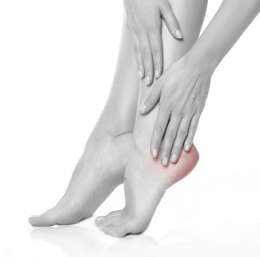A heel bruise is a paralyzing condition, at least for the initial few days and can be very painful too. Know what symptoms indicates a heel bruise, and what measures are taken to treat it, from this piece.

The heel bone in our feet is known as calcaneus. Any trauma or injury to this heel bone results in heel bruise. It occurs when parts of the fat pad which protects the calcaneus, get pushed on the sides of the heel bone, thus, weakening this protective layer on the heel and causing swelling and pain in the process. People who are more susceptible to a heel bruise are sports persons and dancers. Researches have shown that cold weather may sometimes aggravate this condition in people.
What Indicates Heel Bruise?
The symptoms include extreme pain in the heel, which gets exaggerated when the person suffering from it walks downhill. The pain also has a tendency to get worse when the person is participating in such sports that involve a number of direction changes, such as badminton and soccer. Marching up and down in parades, increases the heel pain too. Another symptom is redness and swelling around the heel.
Responsible Factors
» Heel bruise, also known as heel contusion, can occur if there has been an external injury to the heel because of any physical activity, such as exercises.
» Heel bone fracture can lead to a heel bruise too.
» Plantar fasciitis, a condition under which plantar fascia, a fibrous ligament under the heel bone swells, can cause this condition.
» Repetitive strain injury, caused due to repeatedly pounding the heel, can also result in a bruised heel.
Treatment Options
The affected foot should not be moved, at least for the initial seventy two hours. Besides resting the heel, the following home remedies may be followed, to keep the pain in check and to heal the affected area faster.
☞ Applying ice packs or ice to the affected area helps in soothing the heel pain. The earlier cold therapy is given to the affected area, the lesser pain the person will have to go through.
☞ Taping the fat pad on the heel helps in healing the bruise and also shortens the recovery time. If taping is done appropriately, it compresses the soft tissue beneath the heel, thus cushioning and protecting the heel from any kind of pressure or impact.
☞ Keeping the leg at an elevated position helps in treating the heel bruise too.
☞ Applying hot compressions to the injured area can make the healing faster. Massage therapy can provide great relief too. However, precaution should be taken that both heat therapy and massage therapy should be taken only after three to four days after the injury.
☞ Painkillers such as ibuprofen can be taken, especially if the symptoms associated with the bruise become worse. However, if the heel pain refuses to go away and persists for a very long time,i.e. more than a week, it could be due to other conditions such as Achilles tendon injury or a heel spur. In such a case, it is recommended to contact a doctor immediately for proper diagnosis and treatment.
Preventive Measures
» Make use of a heel pad, such as a silicon heel pad, as it helps in lessening the impact of physical activities which put pressure and cause injury to the heels.
» Secondly, wear a footwear with shock absorbers as it helps in avoiding a heel bruise.
» Lastly, doing stretching exercises, especially if you are involved in physical activities such as dancing and sports, can go a long way in preventing this discomforting and painful condition.
One word of caution before I sign off - as mentioned above, if the symptoms worsen and the pain becomes excruciating day by day, a doctor should be contacted without any delay.
Disclaimer:
The information provided in this article is solely for educating the reader. It is not intended to be a substitute for the advice of a medical expert.


 The heel bone in our feet is known as calcaneus. Any trauma or injury to this heel bone results in heel bruise. It occurs when parts of the fat pad which protects the calcaneus, get pushed on the sides of the heel bone, thus, weakening this protective layer on the heel and causing swelling and pain in the process. People who are more susceptible to a heel bruise are sports persons and dancers. Researches have shown that cold weather may sometimes aggravate this condition in people.
The heel bone in our feet is known as calcaneus. Any trauma or injury to this heel bone results in heel bruise. It occurs when parts of the fat pad which protects the calcaneus, get pushed on the sides of the heel bone, thus, weakening this protective layer on the heel and causing swelling and pain in the process. People who are more susceptible to a heel bruise are sports persons and dancers. Researches have shown that cold weather may sometimes aggravate this condition in people.